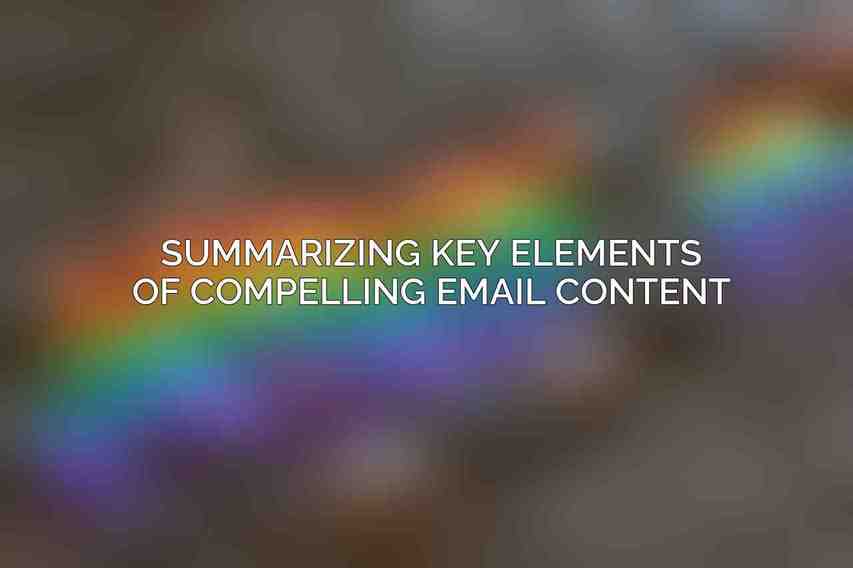The significance of creating compelling email content cannot be overstated. emails serve as a powerful tool for businesses to connect with their audience, drive engagement, and ultimately convert leads into customers. Understanding the target audience and catering to their specific needs and preferences are at the core of crafting impactful email campaigns.
Importance of Compelling Email Content in Today’s Digital Age
Crafting emails that resonate with recipients is essential for standing out in overflowing inboxes. The content must be relevant, valuable, and engaging to capture the reader’s attention. Personalization is key in building a strong connection with the audience, fostering trust, and driving conversions.
Understanding the Target Audience and Their Needs
Before diving into creating email content, it is crucial to conduct thorough research to understand the demographics, behavior patterns, and interests of the target audience. This knowledge forms the foundation for tailoring content that speaks directly to their pain points, desires, and motivations.
Crafting Effective Subject Lines
Crafting an enticing subject line is the first step in enticing recipients to open your email. Here are some tips to create compelling subject lines:
| Tips |
|---|
| Keep it concise (40-60 characters) |
| Use compelling action verbs |
| Personalize with dynamic fields |
| Create a sense of urgency or curiosity |
| Test different subject lines for optimization |
Effective subject lines set the tone for the email content and significantly impact open rates.
Crafting an Enticing Subject Line
A concise subject line that sparks curiosity or urgency is more likely to grab the reader’s attention. Utilize action verbs to prompt recipients to take action, personalize subject lines with their names or preferences, and experiment with different approaches to gauge what resonates best with your audience.
Testing Different Subject Lines for Optimization
A/B testing subject lines can provide valuable insights into what drives higher open rates. Experiment with variations in wording, length, and tone to identify the most effective approach for engaging your audience.
Designing Visually Appealing Emails

The visual appeal of an email plays a significant role in capturing the recipient’s interest. Here are some key elements to consider:
- Optimize for mobile devices (responsive design)
- Use high-quality images and videos
- Employ color palettes and font styles effectively
- Consider using GIFs or interactive elements
- Ensure readability with proper line spacing and fonts
Designing emails that are visually appealing and easy to navigate enhances the overall user experience and encourages interaction with the content.
Designing for User Experience
With the prevalence of mobile device usage, it is imperative to ensure that emails are optimized for various screen sizes. High-quality visuals, cohesive color schemes, and captivating multimedia elements can elevate the aesthetic appeal of the email. Incorporating interactive features like GIFs or videos can further enhance engagement and drive conversions.
Ensuring Readability and Accessibility
Proper formatting, including adequate line spacing and font choices, contributes to the readability of the email. Clear, concise content paired with visually appealing design elements creates a seamless user experience that encourages recipients to engage with the email’s contents.
Writing Engaging Body Copy
The body copy of an email should be crafted with precision to maintain the reader’s interest and guide them towards the desired action. Here are essential tips for writing compelling body copy:
- Use storytelling techniques to captivate readers
- Structure content with a clear call-to-action
- Keep it concise and use bullet points for easy reading
- Personalize the message with tailored content
- Use persuasive language and emotional triggers
Compelling body copy should resonate with the reader, evoke emotions, and lead them on a journey towards conversion. Check this blog on Proven Techniques for Building a Profitable Email List
Incorporating Storytelling Techniques
Storytelling is a powerful tool for connecting with the audience on a deeper level. By weaving narratives that resonate with readers, businesses can cultivate an emotional connection that drives engagement and fosters brand loyalty.
Structuring Content with Clear Calls-to-Action
A clear and compelling call-to-action (CTA) is essential for guiding recipients towards the desired outcome. Whether the goal is to drive website visits, encourage purchases, or prompt sign-ups, a well-crafted CTA serves as a roadmap for the reader to take the next step.
Including a Clear Call-to-Action (CTA)
The call-to-action is the linchpin of any successful email campaign, prompting recipients to take the desired action. Here are key considerations for creating effective CTAs:
| Considerations for CTAs |
|---|
| Define the desired action |
| Use strong action verbs and persuasive copy |
| Make the CTA prominent and easy to click |
| Consider using multiple CTAs throughout the email |
| Track CTA performance to measure effectiveness |
A compelling CTA should be clear, concise, and strategically placed within the email to maximize conversions.
Defining the Desired Action
Before creating a CTA, define the primary objective of the email campaign. Whether the goal is to drive traffic to a landing page, encourage product purchases, or promote a webinar registration, clarity on the desired action is crucial for crafting an effective call-to-action.
Using Strong Action Verbs and Persuasive Copy
CTAs should be actionable and persuasive, prompting recipients to act immediately. Utilize dynamic language that instills a sense of urgency or excitement, compelling readers to click through and engage with the offer or information presented.
Using Segmentation and Personalization
Segmentation and personalization are integral strategies for optimizing email campaigns and enhancing user engagement. Here are key approaches to leverage segmentation and personalization effectively:
- Segment audience based on data (e.g., demographics, behavior)
- Use triggers to send automated emails based on user actions
- Personalize content with dynamic fields and tailored offers
- Avoid sending generic, one-size-fits-all emails
Tailoring content to specific audience segments increases relevance and resonance, driving higher open and click-through rates.
Segmenting Audience for Personalization
By categorizing recipients based on their preferences, purchase history, or demographics, businesses can tailor content to their specific needs and interests. This targeted approach enhances the relevance of the email, leading to higher engagement and conversion rates.
Leveraging Triggered Emails for Automation
Automated emails triggered by specific user actions, such as website visits, abandoned carts, or subscription renewals, enable businesses to deliver timely and relevant content to recipients. This personalized communication fosters a stronger connection with the audience and drives conversions through strategic messaging.
Monitoring and Analytics
Analyzing key metrics and performance data is essential for optimizing email campaigns and ensuring their effectiveness. Here are crucial steps for monitoring and leveraging analytics:
- Track key metrics (open rates, click-through rates, conversions)
- Use analytics tools to analyze performance and identify areas for improvement
- Regularly review results and make adjustments based on insights
Data-driven decision-making allows businesses to refine their email content and strategies for maximum impact and return on investment.
Tracking Key Metrics for Success
Measuring the performance of email campaigns through key metrics such as open rates, click-through rates, and conversions provides valuable insights into their effectiveness. By tracking and analyzing these indicators, businesses can adjust their tactics to optimize engagement and drive desired outcomes.
Leveraging Analytics Tools for Insights
Utilizing advanced analytics tools enables businesses to delve deeper into campaign performance, audience behavior, and engagement patterns. By harnessing these insights, organizations can fine-tune their email content, segmentation strategies, and overall approach to maximize results.
Ethical Considerations
Ethical considerations play a vital role in email marketing practices, ensuring transparency, trust, and compliance with regulations. Here are essential factors to keep in mind:
- Respect and comply with privacy regulations (e.g., GDPR)
- Avoid deceptive or misleading content
- Ensure clear and explicit opt-in processes
Maintaining ethical standards in email marketing builds credibility, enhances reputation, and fosters long-term relationships with subscribers.
Respecting Privacy Regulations
Adhering to data protection laws such as the General Data Protection Regulation (GDPR) is non-negotiable in email marketing. Obtaining explicit consent from recipients, safeguarding their personal information, and providing clear opt-out mechanisms demonstrate a commitment to privacy and trustworthiness.
Promoting Transparency and Trust
Transparency in communication, honest practices, and clear opt-in procedures are foundational to fostering trust with subscribers. Avoiding deceptive tactics, misleading claims, or unsolicited emails cultivates a positive brand image and promotes ethical engagement with the audience.
creating compelling email content that converts requires a strategic and holistic approach that encompasses various elements, from subject lines to CTAs and personalization. By prioritizing audience understanding, crafting engaging content, and leveraging analytics for optimization, businesses can elevate their email marketing efforts and drive meaningful results.
Summarizing Key Elements of Compelling Email Content

Businesses must focus on delivering value, personalization, and relevance to their audience. By consistently refining their strategies, testing new approaches, and adapting to evolving consumer preferences, organizations can nurture strong customer relationships and drive conversions effectively.
Emphasizing the Importance of a Holistic Approach
A comprehensive strategy that integrates creative content, data-driven insights, and ethical practices is essential for building a successful email marketing campaign. By combining these elements cohesively, businesses can establish a strong brand presence, nurture customer loyalty, and achieve their marketing objectives.
Encouraging Continuous Improvement through Testing and Analysis
Continuous evaluation, experimentation, and optimization are key to the ongoing success of email marketing initiatives. By embracing a culture of learning, adaptation, and innovation, businesses can stay ahead of trends, meet customer expectations, and drive sustainable growth through compelling email content that converts.
mastering the art of creating compelling email content involves a strategic blend of creativity, data insights, and ethical considerations. By focusing on audience needs, personalized messaging, and performance tracking, businesses can craft emails that resonate with recipients, drive engagement, and ultimately convert leads into loyal customers.
Frequently Asked Questions
What is the importance of creating compelling email content?
Creating compelling email content is crucial because it helps capture the attention of your audience, leading to higher engagement and ultimately more conversions.
How can I make my email content more engaging?
To make your email content more engaging, try to personalize your messages, use a conversational tone, include relevant visuals, and provide valuable information to your recipients.
What are some tips for improving email conversion rates?
Some tips for improving email conversion rates include A/B testing different content, optimizing your subject lines, creating a sense of urgency, and providing clear call-to-action buttons.
Why is it important to understand your target audience when creating email content?
Understanding your target audience is important because it allows you to tailor your messaging to their specific needs and preferences, increasing the likelihood of conversion.
How can I measure the effectiveness of my email content?
You can measure the effectiveness of your email content by tracking metrics such as open rates, click-through rates, conversion rates, and overall engagement with your messages.

